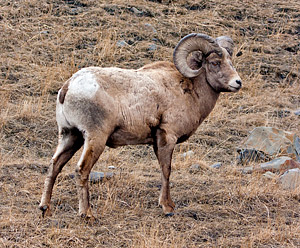|
 |
Bighorn sheep have become the hot topic among hunters in Alberta as of late.
And with Sustainable Resource Development (SRD) looking at changes to sheep hunting regulations in Alberta, possibly as soon as this year, died-in-the-wool sheep hunters are concerned about hunting opportunities being reduced. And lost opportunity is always a contentious issue.
Then, on February 7th, as those possible regulation changes were ongoing, a concerted effort between volunteers and Fish and Wildlife staff from both Alberta and Nebraska, captured 40 bighorn sheep, 35 ewes and five rams, for translocation to Nebraska.
The sheep were net-captured from the reclaimed Teck Mine site near Hinton, an area that boasts a large number of bighorn sheep. In fact, biologists believe the area may be at its carrying capacity, and with that comes disease concerns.
 |
| “Suggesting that Alberta keep its sheep for itself is asinine, especially in light of such large populations on reclaimed, mostly unhuntable mine sites.” |
But many Alberta sheep hunters were upset, suggesting that perhaps those sheep should have been transplanted in other areas of Alberta, not Nebraska. And that we should be addressing our sheep problems, not theirs.
Especially in light of sheep hunting regulations being discussed for change right here at home.
However, Alberta is well known for its bighorn sheep population and has been involved in bighorn sheep translocations for many years. Since 1922, more that 600 bighorns have been translocated to other regions of the United States and western Canada to help restore herds in those areas.
The Cadomin region of Alberta is in itself a Mecca for bighorn sheep. And for the most part, these sheep are protected from both hunting and predation, and the habitat there is perfect. Which equals a flourishing population of sheep that needs reduction on occasion, less disease becomes prevalent.
And what better way to do that than translocate some of those sheep to an area that hasn’t held sheep in 100 years, but contains prime sheep habitat, as the land near Fort Robinson State Park in Nebraska does.
Albertans should be proud of the rich diversity of wildlife they have in this province. Sharing some of those abundant species with other regions where they once existed is a prospect that is not only exciting, but also proper.
This allows the species to reestablish itself in a former range while allowing control of an expanding population in an existing range.
Alberta has also translocated wolves and elk to regions where help was required to restore those populations.
In turn, Alberta has also sought help reestablishing species that are threatened or endangered here, most recently sage grouse being translocated to Alberta from northern Montana.
As Neil Waugh wrote in the July 2011 issue of Alberta Outdoorsmen, “Eastern gobblers and badlands bighorns, why the heck not?” Neil was referring to a couple of ongoing projects that would see eastern turkeys introduced to Alberta, as well as bighorn sheep introduced, or perhaps re-introduced, to Alberta’s rugged badlands.
In the case of the badlands bighorns, proof needs to be established that this part of Alberta was once bighorn sheep range.
But eastern turkeys in Alberta may not be so far away.
Helping wildlife reestablish itself, and in some cases, albeit few, introducing non-native species like eastern turkeys into new range can have tremendous positive effects, both economically, and for the benefit of the species. Reintroductions should be heralded, because it is recognition of the fact that we have broken something and that it needs repair.
This is an amazing process; where one jurisdiction can help another when wildlife needs help. Wildlife agencies across North America, working together on behalf of wildlife is an accomplishment of highest regard. This is something that hunters, conservationists, or anybody who considers wildlife the incredibly valuable resource they are, should be proud of.
Suggesting that Alberta keep its sheep for itself is asinine, especially in light of such large populations on reclaimed, mostly unhuntable mine sites. It is estimated there could be as many as 1200 sheep in this part of Alberta, and it’s a growing population.
These 40 sheep will create a new herd in Nebraska and bring its entire bighorn sheep population to about 350, a far cry short of their goal of 600 statewide, and an incredible number distant of Alberta’s sheep population. Sheep from South Dakota, Colorado, Montana, and now Alberta have been translocated to Nebraska over the past three decades.
It should be noted that three ewes died during the translocation, two on site, and one en route to Nebraska.
Back at home, in time, and with a proper budget, wildlife managers may look at relocating sheep in Alberta, perhaps even to our southern badlands.
But until that time comes, helping out other regions where sheep once lived is just the right thing to do. It will give hunters in those regions the opportunity to hunt a healthy population of bighorns in the future. This is about opportunity, opportunity to help restore what once was in another region, opportunity for Nebraska’s sheep hunters, and opportunity for those Alberta bighorns. ■
For previous Outdoor Pursuits click here.
|
|
|
|


